The Aztec religion is a Mesoamerican religion that combines elements of polytheism, shamanism and animism, as well as aspects related to astronomy and the calendar. Aztec cosmology divided the world into three levels: an upper one, seat of the celestial gods, a lower one, seat of the underworld powers, and a middle one, in which the human consortium lives, equidistant from the gods and demons of nature and the subsoil. The concept of Theotl it is fundamental in the Aztec religion. In language Nahuatl it is often considered synonymous with "God", even if, to be more precise, it refers to a more general concept, which refers to the immaterial dynamic energy of divinity (tona), similar to the Polynesian concept of mana. As the Tapas of the Indo-Aryans, this tona it is not always beneficial, since an overabundance of it brings death and destruction [Torres 2004, p.14].

According to mexica mythology, each star embodies a certain character: the deities have "sacrificed" themselves, so to speak in illo tempore to reincarnate in the stars. Thus, for example, Quetzalcoatl transformed himself into the planet Venus, the morning star, which therefore can be worshiped in the triple symbolic form of dynamic energy, of star and personified, as a cultural hero. In turn, the Sun, the main source of tona or vital heat, arises from the immolation of Nanahuatzin [Torres 2004, pp.13-14]. In the Aztec religion, therefore, a role of primary importance was played by the planets and the stars, each of which were associated with different symbolic and religious meanings, and were linked to gods and geographical places. A considerable part of the pantheon Aztec was a legacy of previous Mesoamerican civilizations and other peoples (Olmecs, Toltecs, etc), such as Tlaloc, Quetzalcoatl and Tezcatlipoca: they were gods worshiped with different names from the previous cultures of Mesoamerica.
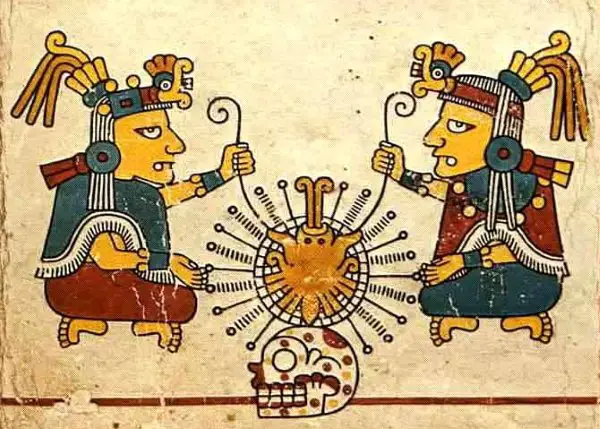
The creator gods of the origins
 On top of the pantheon Aztec were found the creator gods. The first to come into existence was the one God, Creator of all things and ruler of the thirteenth heaven: ometeotl. In turn, he split up in illo tempore in a female part (Omecihuatl) and in a masculine one (Ometecuhtli). We are immediately faced with a cornerstone of Mexican mysticism: being, at whatever level it is, can always be divided into two polarities opposite and complementary, one of which it always needs the other in order to continue marking the rhythm, space and cosmic times.
On top of the pantheon Aztec were found the creator gods. The first to come into existence was the one God, Creator of all things and ruler of the thirteenth heaven: ometeotl. In turn, he split up in illo tempore in a female part (Omecihuatl) and in a masculine one (Ometecuhtli). We are immediately faced with a cornerstone of Mexican mysticism: being, at whatever level it is, can always be divided into two polarities opposite and complementary, one of which it always needs the other in order to continue marking the rhythm, space and cosmic times.
In the Mesoamerican perception we therefore find one God (Ometecuhtli), who was considered otiosus because he lived at the peak of creation, in the 13th heaven, from which two portions of the very essence of the god emerge and begin again a long chain of creation of new divine entities, subject to them. The masculine and feminine attributes of a main god are continually separating, level by level, sky by sky, from the higher to the lower, thus creating a vast array of gods with ever more defined characteristics.

The God residing in the highest heaven, “the Lord Two“, Unique to contain the seeds of any existing duality and polarity in potential in the cosmos, it is the Latin equivalent of Janus, the two-faced god of beginnings and origins, and the Hellenic one of Uranus, which Dumezil recognizes in the Indo-Aryan equivalent of Varuna, the infinite sky. The two masculine and feminine polarities in which we depart recall the Latin couple formed by Opi and Saturn (Omecíhuatl and Ometecuhtli were also called "the lords of sustenance" and we well know how the couple of Latin primordial divinities were inextricably linked to the fertility and agriculture), not to mention the divine Hindu couple formed by Shiva and Shakti. These two higher principles into which Ometeotl originally divided- thus becoming a typical deus otiosus, exactly as happens to Uranus (son of Aether, the upper Heaven), and Varuna — they give life and they rule every power that comes into existence in the lower heavens. Also, the Mexica called heaven ilhuical, meaning with this term "the vast expanse of the ocean which in their eyes resembled it or perhaps was the same thing" [Torres 2004, p.17]: it is impossible not to notice in all this an evident correspondence with the Hellenic Okeanos, from Whose supernal streams all gods have had life.
Tlaloc and the brother gods Tezcatlipoca and Quetzalcoatl
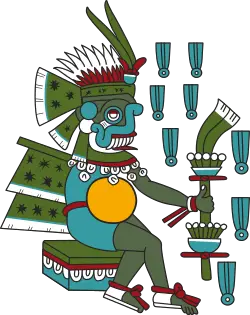
In turn, Omecíhuatl and Ometecuhtli give life to the four most revered gods of pantheon mexicano, sons of the primordial couple, called i four tezcatlipocas: Xipe-Totec, Tezcatlipoca, Quetzalcoatl and Huitzilopochtli, also considered as the gods of the four cardinal directions (respectively West, North, East and South) and of the four colors (respectively red, black, white and blue). To them is added Tlaloc, a very ancient Toltec god of the waters, similar to the Latin Neptune and the Hellenic Poseidon, in turn assisted by four hundred tlaloques, his assistants and subordinates (note that in some very ancient Hellenic myths, of which Plato mentions, Poseidon was the lord of Atlantis and ruled over the race of the Titans in the mythical polis which took its name from him).
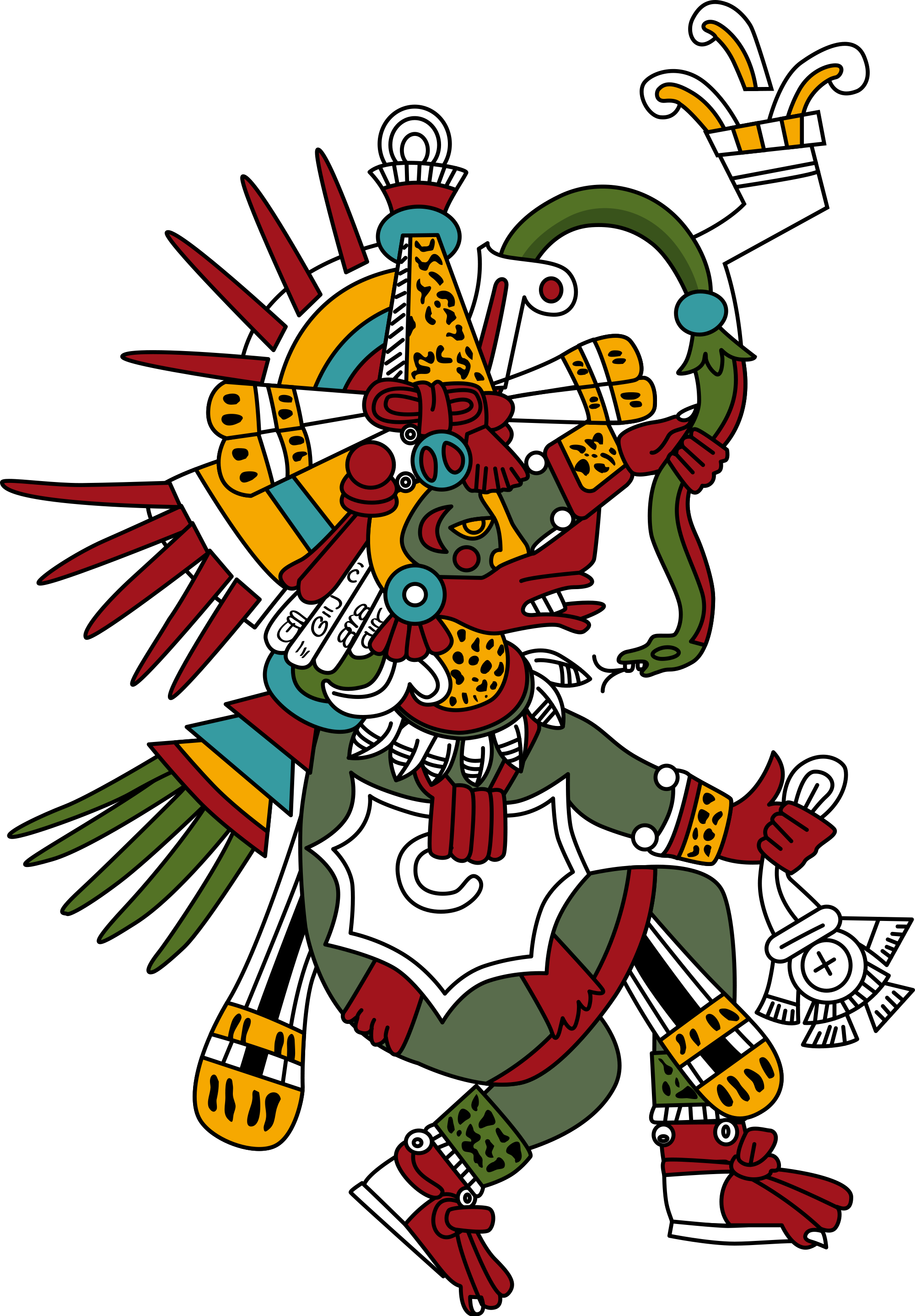
Quetzalcoatl, god of the air and of the planet Venus, patron of the priesthood, of wisdom and of merchants, has many traits in common with Norse Wotan and Latin Mercury, as well as being "the supporter of the sky" like the Hellenic Atlas. He is also comparable to Prometheus in the credit he is acknowledged to have brought culture and mantic — the The fire the giant Hellenic stole from Zeus — the human race, and in fact Quetzalcoatl is also revered as a cultural hero of ancestral memory. We are clearly faced with a recurring series of pattern which can be found in countless mythical corpus of archaic memory.
Tezcatlipoca and Quetzalcoatl, creators of the world and humanity, in the mythical corpus of the Aztecs they were also very ancient gods who formed a pair of polarities, sometimes in harmony, sometimes in conflict with each other (the mythical motif that recurs here is that of the divine couple of twins, present in almost all ancient mythologies, from Castor and Pollux to Romulus and Remus). Simplifying, the former represented darkness and wickedness, the latter light and goodness. Quetzalcoatl is said to have brought prosperity to Tula / Tollan (note the similarity with the legendary island of Tulle mentioned for the first time in the travel diaries of the Greek explorer Pytheas, who described it as "a land of fire and ice in which the sun never sets", located in the far north of the world). In the myths of the Aztec tradition, the city of Tula is linked to water and the Toltecs claimed that its inhabitants used “blue colored blankets and dresses and shell-shaped headdresses” [Torres 2004, p. 75].
Furthermore, they narrate, this city already existed before the birth of the Sun (today) and was inhabited by the Ancestors, the first men, sometimes represented in sacred iconography in the form of skeletons. Once again, we come across myths that strongly recall the Platonic myth of Atlantis and various aspects of it that the secret Mediterranean tradition, as well as the Mexica one, has passed down orally for millennia. We add that, according to the Aztec myth, the first men were originally from Chicomoztoc, "The seven quarries" (a number that always recurs in the founding myths of ancient populations - for example the seven hills of Rome - which esoterically recalls the seven stars of the Ursa Major), a "legendary location that would be found in an unspecified point in the far north "and it was believed that even the dead lived in the far north, which is the" region of darkness "and - says Eduard Seler - at the same time" the place of the constellations which are in perpetual motion, which are not never set, the region of those who live eternally, the homeland of the departed ”[Helfritz 1968, p.128].

tezcatlipoca (literally "smoking mirror") is an omnipotent god giver of life and death, personifying the burning summer and winter and, as we will be able to ascertain, the constellation of the Great Bear. When he arrived in Tula he defeated Quetzalcoatl, sent him into exile (although other myths claim that it was Quetzalcoatl himself who left, out of a sort of disapproval of the abandonment of sacred customs by the population he civilized and ruled) and changed the genre human in monkeys.
Huitzilopochtli and Coyolxauhqui
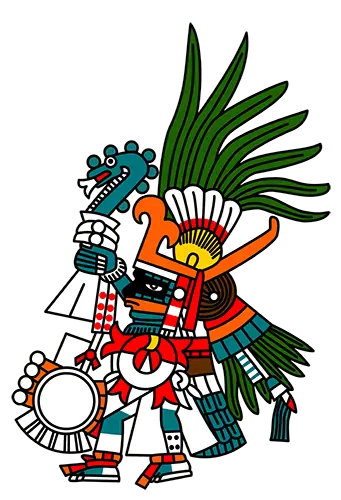
Other parallels are found for Huitzilopochtli, god of war and storm, personification of the daytime sky who embodied and supplanted an older sky deity - just as Zeus, dethroning Kronos, arose as avenger of his grandfather Uranus, and in the same way of the Vedic Indra who supplanted older celestial deities such as Dyaus and Varuna - and for his messenger Painal (from painalli, or run fast) god of merchants but also of doctors and medicine, clearly a Mercury-Hermes mexicano. Again: the "Lady of the Night" Yoaltecuhtli, was considered the personification of the "night wind", named — surprisingly—hecatl (impossible not to notice the assonance with the name of the Greek-Roman goddess, although of pre-Indo-European origin, Hecate, lunar deity of the night, of witchcraft and of darkness).
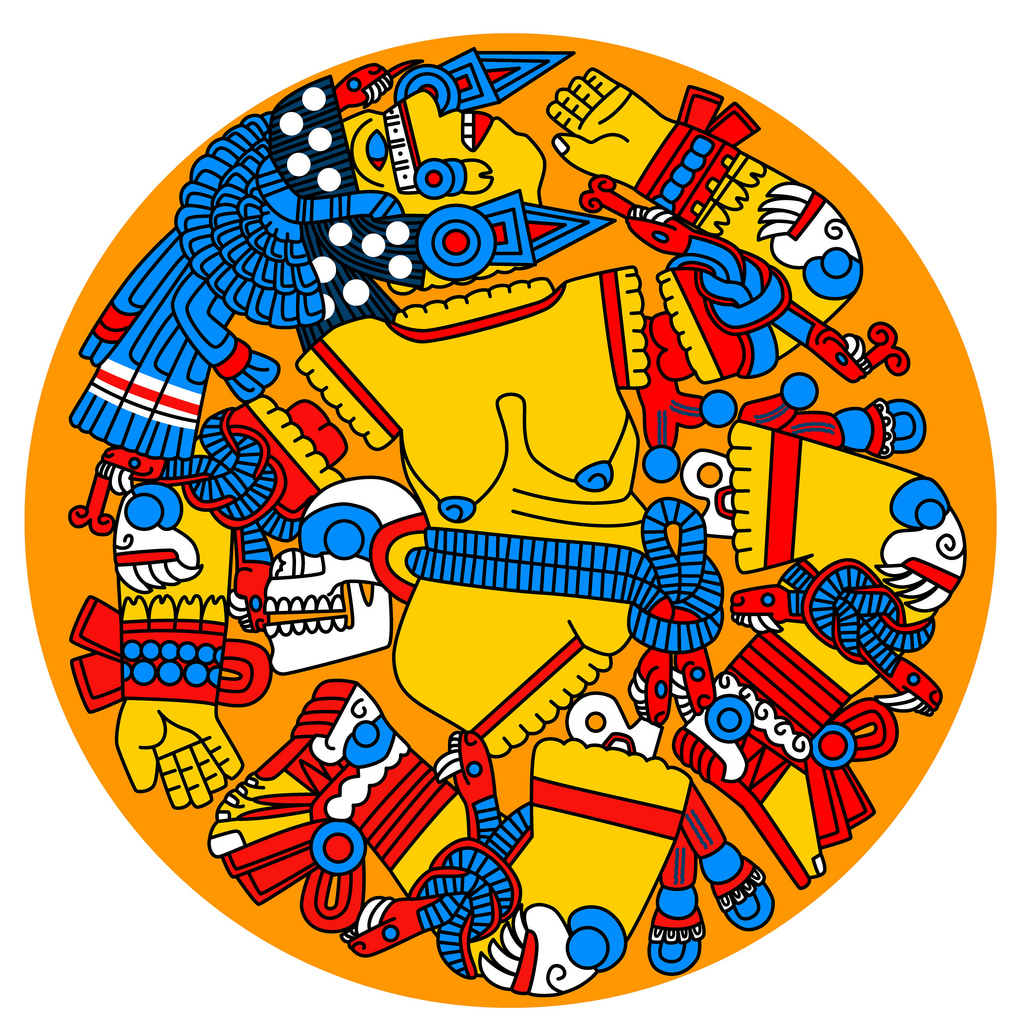
Returning to Huitzilopochtli, we find it appropriate to mention the classic myth of his birth: he emerges from his mother Coatlicue "in all his strength and in all his glory", he fights against his sister Coyolxauhqui ("the one with rattles on its face“), Kills her and tears her to pieces. Finally, he puts his brothers, the Centzon Huitznahua to flight [Torres 2004, p.80]. Reminiscences of an ancient planetary collision, which took place in today's asteroid belt, which caused the destruction of the "cosmic monster" Coyolxauhqui (a primordial moon, existing in an earlier eon; equivalent to the Hellenic Typhon and the Sumerian Tiamat whose body was torn apart, according to the Akkadian myth, the world, the earth and the sea would have formed) —a planetary body which, in ancient times, occupied the orbit between the planet Mars and Jupiter? All the data in our possession, however hermetic, lead us to think so: on the other hand, it is precisely Zeus in the Hellenic myth and Marduk in the Sumerian one, both personifications of the planet Jupiter, to destroy the foreign body in a battle with no holds barred. .
Aztec myths also lead in this direction: la portion of the fifth sky is in fact called the "Atllachinolli region“, Literally“ the region of water and fire ”, that is“ of war ”. It is thought that this place was the seat of the teoyaomiqui, the warriors who died in the war, and of the mocihuaquetzque, women who died in childbirth [Torres 2004, p.18]. Both became quauhtecatl, "Companions of the eagle" or "companions of the Sun"; they entered his kingdom and followed him every day in a festive procession, on his way across the firmament [Helfritz 1968, p.140]. It is practically impossible not to find in these beliefs an evident similarity with the Valhalla Old Norse ruled by Wotan, in which they arrived after death—In fact — the warriors who died in battle and the women who died in childbirth. In cosmic geography - as we have previously hypothesized - this portion of the sky is equivalent to the asteroid belt located between the sky of Mars and that of Jupiter: an orbit in which it is handed down that, in the mists of time, a planetary collision occurred which caused the destruction of a celestial body (the primordial moon) and the birth, depending on the various myths, of the Earth or the Sun of the current cycle. But we will return to this point later.
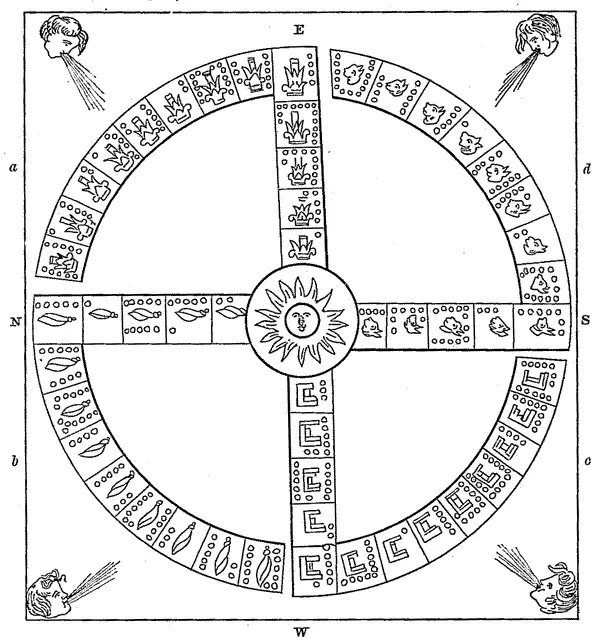
The four ages
It is necessary here to recall that the Mexica believed they existed four cosmogonic ages: at the beginning of each of them, a god is transformed into the new sun and the Earth "is reborn" and is inhabited by new species of beings. According to the myths, there were, as it were, four phases of creation, during which some of the major deities took turns taking on the role of the sun. Each of these stages ended because none of the gods were satisfied with the men he had created. The Mexican populations were therefore convinced that the present sun had been preceded by four other suns, that is, by four prehistoric eras. The celestial bodies, the earth and its inhabitants were not created simultaneously. How not to find a parallel with Hesiod's four ages and with the division of the aeon into four Yuga theorized by the Hindu tradition, and above all with the five cycles of the Andean-Inca doctrine of Pachacuti [cf. Pachacuti: cycles of creation and destruction of the world in the Andean tradition]?

The age of the Giants
In short time il primeval sun fu tezcatlipoca, but - maybe because he had one leg, or perhaps because he was the god of the night — he only managed to become a mezzo Sun. According to one version of the myth, the world continued in this state of starvation for some time and a mixture of brotherly rivalry, frustration and ambition grew in Quetzalcoatl, until he decided to throw his brother out of the sky with a stone club (this myth recalls the Hellenic one of Hephaestus, too lame, thrown down from heaven by Hera). Without the sun the world was completely dark, and filled with anger Tezcatlipoca ordered his jaguars to eat all the people, who in those days were giants. Another version, however, claims that Tezcatlipoca itself he created a half sun, which "his jaguars ate before the giants" (a parallel with the Hellenic Kronos devouring his own children?). Investigating this version of the myth, the doubt arises that the term "sun" to define the regent god of each era is incorrect, as it seems evident that the god who reigns over the cosmos from time to time rather creates a sun that remains in the heavens for an entire phase of the cycle. According to Alexander von Humboldt, the "it was battles against giants (ie the era of the First Sun) lasted 5256 years "and the famine" saw the extermination of the first human generation "whose components were transformed into birds [Helftritz 1968, p.129]

The Age of Fire
However, in most myths, the first age of humanity is considered to be that of According to Sun, Tlaloc (the planet Saturn), and for this reason the calculation of the eras starts from this moment and not from that of the First Sun, the primordial Tezcatlipoca "from a single lega ", which in all probability did not represent a real planet but the constellation Ursa Major (on the symbolism of the lame gods as a representation of theUrsa Major, see Hamlet's mill).
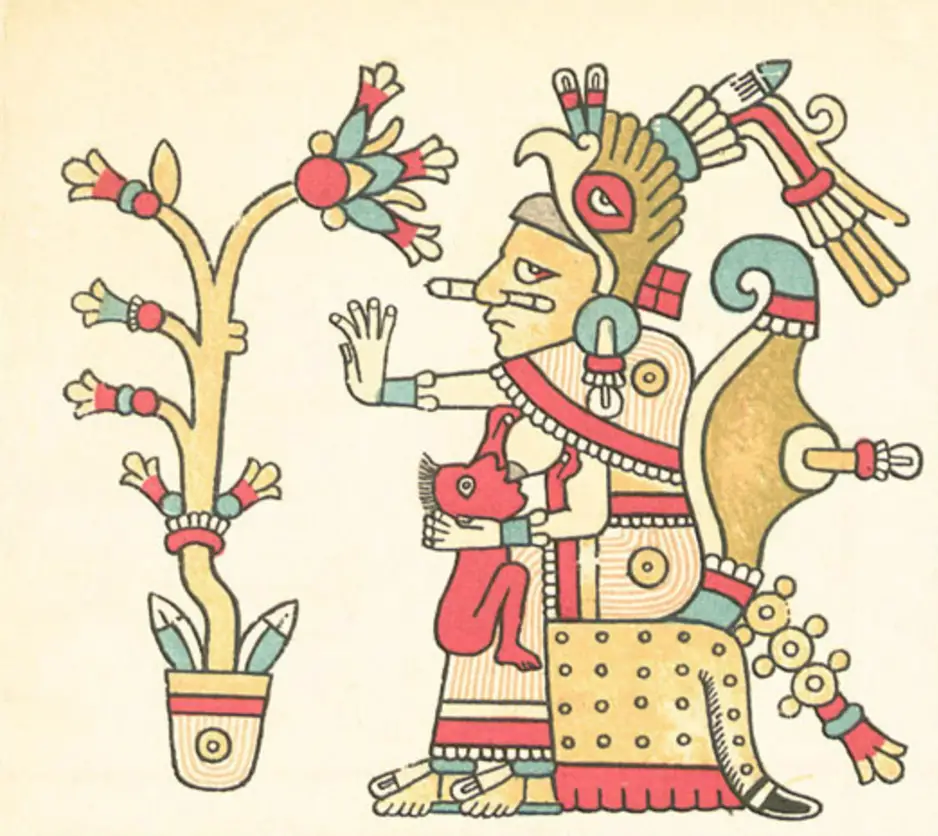
In the first of the four historical eras mentioned by the Aztec tradition, it was therefore Tlaloc who became / created the Second Sun, but the revived Tezcatlipoca seduced his wife xochiquetzal, goddess of love, flowers and corn. This myth would seem to trace the Mediterranean one of the abduction of Persephone / Proserpina - as the Aztec goddess "was kidnapped and sent to the nine inferior levels placed inside the earth" to be delivered to darkness or the kingdom of Mictlantecuhtli, god of death (the equivalent of the Latin Pluto, the Hellenic Hades and the Vedic Yama).
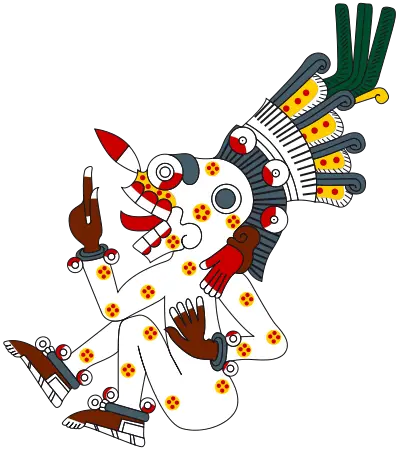
Nonetheless, this mexica myth also closely resembles the betrayal of Venus / Aphrodite against the husband Vulcan / Hephaestus; even Tezcatlipoca, also considered a god of war and beauty, perfectly plays the role of Don Juan Mars / Ares. In the Aztec myth, due to this betrayal, a great drought hit the world. Eventually, with a great firestorm Tlaloc burned the entire Earth and the gods built a new Earth with the remaining ash. With this cataclysm of fire the era of the Second Sun ended, lasting a total of 4804 years, also called Age of Fire.
The age of the wind
In the second of the four historical eras, i four tezcatlipocas they descended to Earth and created a race of giant men, over whom he ruled Quetzalcoatl, which also imposed (as the planet Venus) its lordship on the Third Sun. As we have seen, however, as the years went by, humans on Earth became less and less civilized and attentive to the gods. Tezcatlipoca decided it was time to take revenge on his brother and, as the god of judgment and magic, he turned men into apes. Quetzalcoatl, who loved men for what they were, grieved and with a terrible hurricane blew all the apes off the face of the Earth. For this the era of the Third Sun is also called Wind age.

Quetzalcoatl's descent into the underworld and the resurrection of mankind
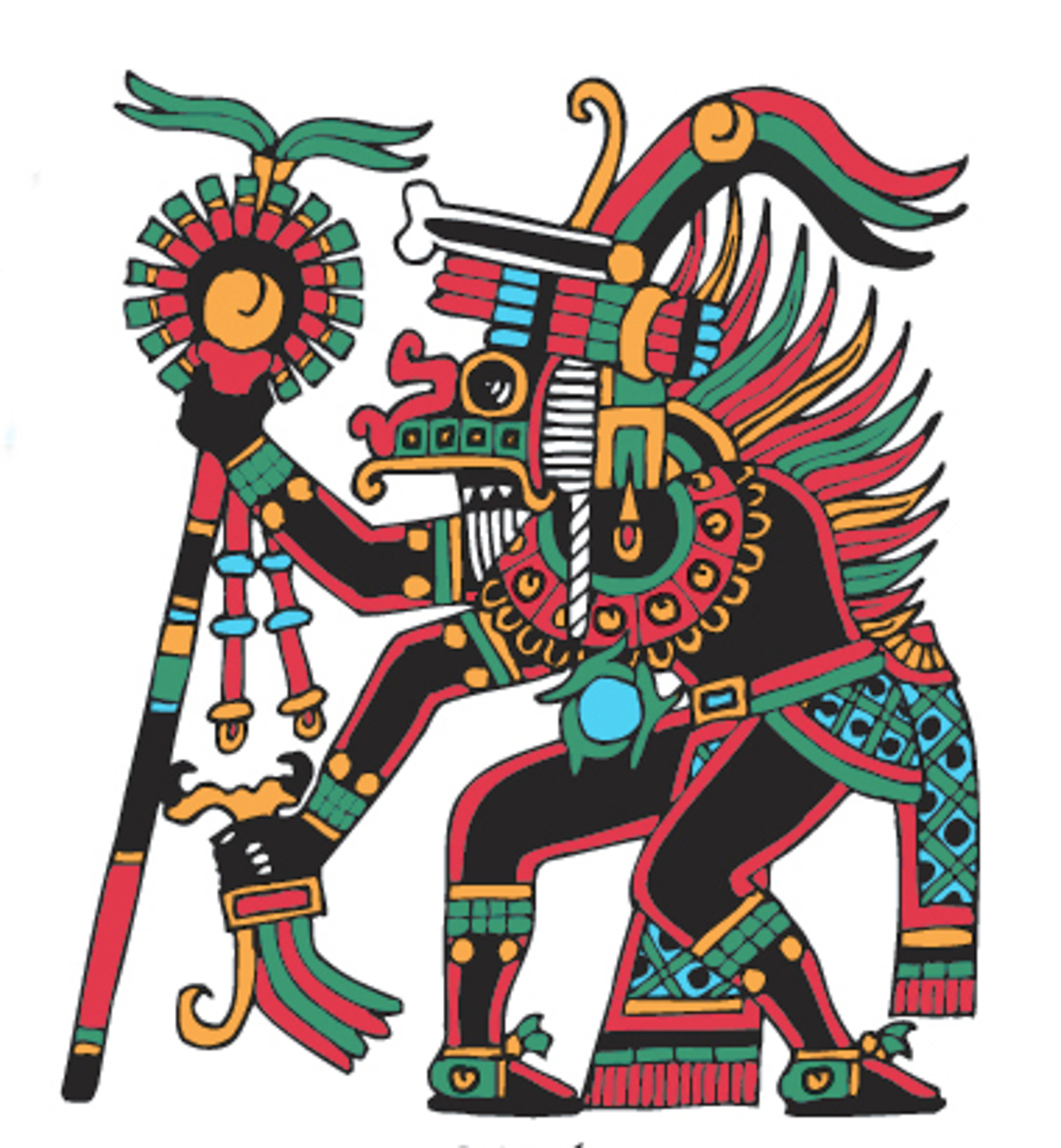
Quetzalcoatl, however, did not willingly accept the destruction of mankind and, after descending into the underworld, stole their bones, then dipped them in your own blood to resurrect mankind. This reminds us of the Egyptian myth of the death of Osiris and of his rebirth in the new garments of God of the Underworld [cf. Divinity of the Underworld, the Afterlife and the Mysteries]: several myths describing the passage of a divine power (theotl) from the lordship over the kingdom of the living to that over the kingdom of the dead, following a — so to speak— "handover": Quetzalcoatl, Third Sun, at the end of the predetermined time, leaves the lordship to his successor, as well as Osiris he does with his son Horus. When we also read that Quetzalcoatl, in his descent into the underworld, was accompanied by his brother xolotl, who "wore a mask with the features of a dog", not thinking of the Egyptian psychopomp god Anubis, companion of Osiris with sometimes lunar and sometimes mercurial characteristics (exactly like Xolotl) becomes a real challenge. It is also likely that Xolotl and Anubis are mythical representations of Sirius, who is vitally important in many ancient wisdom cults and is often referred to as "the Dog star". This seems indeed quite plausible also due to the fact that Venus and Sirius are often associated (the first as "Morning Star", the second as "Evening Star") and therefore the mythical friendship and dualism existing between Quetzalcoatl and Xolotl should be read in this sense.
Xipe-Totec "Our Lord the Flayed"

Osiris is also closely related to Xipe-Totec ("Our Lord the Flayed"), was a Mixtec deity (in our opinion similar to the Aztec Nanauatzin, which we will discuss later). He was a deity who presided over rebirth, the passage from death to life and vice versa, god of agriculture and of the seasons (especially spring), of the West, of diseases and of blacksmiths. During the annual feast in his honor, a chosen one was selected to play the role of "fake king" for a day, at the end of which he was sacrificed to the god (a rite almost identical to the Roman Saturnalia). It is said that Xipe-Totec took off his skin to nourish humanity: his symbol is the seed of corn, which loses its outer rind in order to germinate. He was depicted skinless, like a golden god, or with a second human skin.
Of course, all of this is also incredibly reminiscent of the myth of Dionysus captured as an infant by the Titans, dismembered, boiled, roasted and eaten, then reborn to a new life, and the ritual dismemberment that the bacchantes, possessed by the god, performed in his honor in ancient Hellas [cf. Cernunno, Odin, Dionysus and other deities of the 'Winter Sun']. He too god of vegetation, like Osiris and Xipe-Totec, the myth of him is a leitmotiv which is repeated over the millennia of the known history of religions, from the sacrifice of Tammuz / Adonis to that of the Norse Baldr, up to the most recent myth, that of the death and rebirth of Christ who — note — having been horribly disfigured on all his limbs during the flogging preceding the crucifixion, falls by right into the category of "flayed gods" as well as those reborn to a new life. Note here also the parallel between the various descents into hell of Osiris and Quetzalcoatl and that of Christ, who "descended into hell" and released the anime from the underworld and darkness, bringing them back to life — as well as the Aztec god "he stole the bones and dipped them in his own blood to resurrect mankind". All this, obviously, cannot be the result of chance.
The inclination and fall of the "great pole"
The Aztec tradition mentions "a very high pole" located in the town of Zapacu: it was, according to the myth, a "very large trunk from which the gods descended from heaven" [Torres 2004, p.30]. This pole inclined at the end of the first era - that is, the mythical period that the Latins call the Golden Age or the Age of Saturn and the Indo-Aryan tradition calls Satya-Yuga—and finally collapsed with the end of the second (the Silver Age, the Treta Yuga) thus making it inaccessible to man the way to heaven and to the divinities, and thus starting an inexorable process of cosmic involution and the new era, that of Water.
The Age of Water

The third era sun was (created by) Chalciuhtlicue / Acuecucyoticohuati, who became Tlaloc's new wife, as well as the governor of Fourth Sun (this era is called by the Hindus Dvapara Yuga and from Hesiod Bronze Age). The goddess was very fond of men, but Tezcatlipoca — in typical dress robes trickster reminiscent of the exploits of the Norse Loki — he accused her of masking her selfishness of receiving prayers from men under the pretext of selfless love. Chalciuhtlicue was so affected by this accusation that she wept blood for the next 52 days, causing a terrible flood that drowned all the inhabitants of the Earth.
The current era
After a tough battle, Huitzilopochtli defeated the goddess, restored cosmic order, and made himself lord of Fifth Sun and of the fourth era, still in progress, ruling over the new sun, the one already mentioned several times Nanuatzin, that we had previously related to the Mixtec "flayed god" Xipe-Totec. This god, son of Tlaloc and Acuecucyoticohuati, in Aztec beliefs "immolated himself by throwing himself into a gigantic bonfire" thus becoming the current sun.
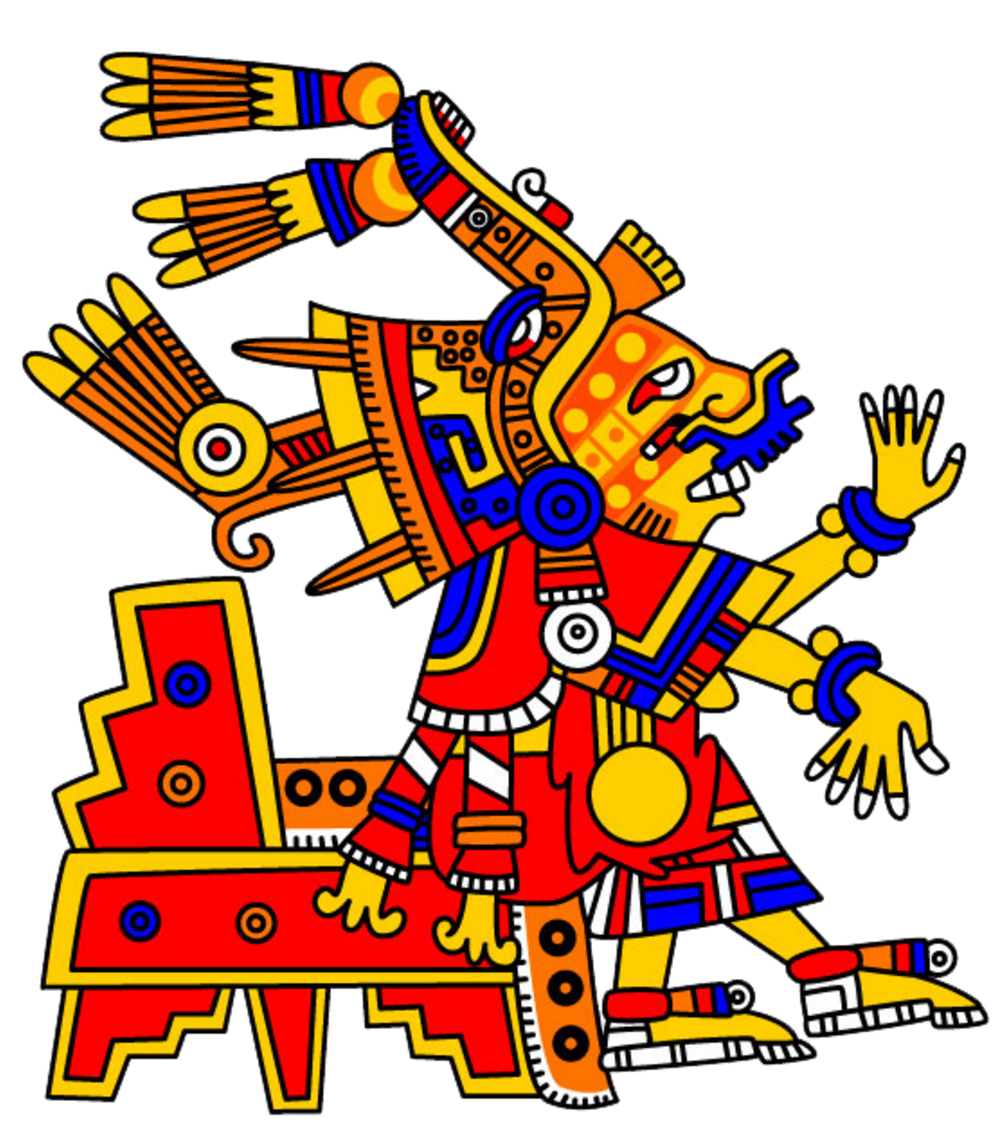
It seems evident to us that this solar divinity, who dies and is reborn, is in all respects similar to the various Osiris, Dionysus, Tammuz, Baldr, Christ mentioned above. His sister too Tecuciztecatl it sacrificed itself at the end of the third era, becoming the present moon. That of Nanuatzin is the last age, which will end when the Earth collapses on itself following repeated seismic tremors (for this reason it is also named as age of earthquakes). Finally the tzitzimime, a tribe of monstrous goddesses made only of bones, would emerge from the darkness to annihilate humanity. The final catastrophe, similar to the Twilight of the gods Germanic and al Ragnarok Old Norse: the Twilight of the gods and the fall of the heavens.
The goddess of a thousand names

Drawing the conclusions from what emerged previously, it seems reasonable to place at this precise moment, in the passage between the third and fourth (or between the fourth and fifth, the present), the cosmic clash that took place between Huitzilopochtli (the planet Jupiter) and the mysterious Chalciuhtlicue / Acuecucyoticohuati / Coyolxauhqui.
Following Ariadne's thread of the various myths, from the mythical dismemberment of this primordial divinity (which, we recall, is the equivalent of the Sumerian Tiamat and the Greek Typhoon), the present moon was born - a myth specifies that Huitzilopochtli beheaded Coyolxauhqui "by using it the head to make the moon "- the current sun - a song referring to Huitzilopochtli says:" Thanks to me the Sun was born "[Torres 2004, p.65] - the new Earth (that of the fourth era, the current one) , and also that peculiar spatial region between the orbits of Jupiter and that of Mars that astronomers have called the asteroid belt and, perhaps, even the current planet Mars, as the myth of tonatiuh according to which he “acts as bridge between Nanauatzin (the present sun) and Huitzilopochtli "; he was wounded, but he rejuvenated “throwing himself into the fire and becoming the sun warrior", wandering the heavens "with the souls of those who died in battle." All this, among other things, brings us back to Norse mythology, and more precisely to the legend of Wutendes heer, the "raging army" of warriors who died in battle that accompanied Wotan - god, among other things, of war - in a whirlwind swirl around the Earth [cf. The Friulian benandanti and the ancient European fertility cults].
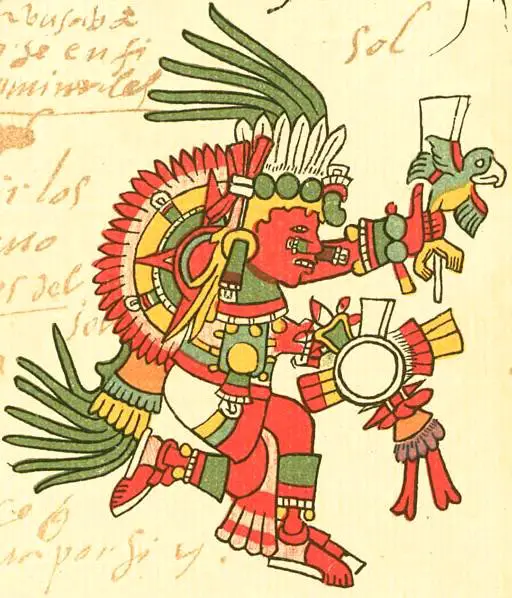
It remains to be noted here how, the more we delve into the myths, the more the multiform goddess Coyolxauhqui / Chalciuhtlicue / Acuecucyoticohuati, "mother of all things", appears to us more and more clearly to be a planetary body of ancestral memory, a sort of primordial moon, which it competed in "splendor" and "might" with the planet Jupiter, lord of the present era and which was dismembered at the beginning of the present era, exactly as it had previously happened to the gods of previous eras. If we accept, as we have done so far, a cosmogonic reading of the mythical events narrated, we can conclude without too many doubts that the planet Jupiter (Huitzilopochtli) "in all its strength and in all its splendor", at the beginning of the current era , colliding with the ancestral primordial moon, the birth of today's Sun (Nanuatzin), of the present Moon (Tecuciztecatl), of the Earth on which we live and even of the planet Mars, if we accept its correspondence with the god Tonatiuh. An ancient truth that, for us Westerners, could be contained in the myth of Zeus who, with a stratagem, administered to his father Kronos (equivalent to Tlaloc) a potion that induced him to throw up the previously devoured children (including Ares, Apollo and Diana - precisely Mars, the Sun and the Moon) with the help of which he then waged war against him and conquered dominion. On the other hand, it is well known in the scientific field how the intense gravitational field of Jupiter influences the solar system in its structure by perturbing the orbits of the other planets and "cleaning" it of debris that would otherwise risk hitting the innermost planets. A task that the planet would carry out for infinite eons, and which has remained indelible in the mythologies of the most ancient peoples of our world under various denominations and legends: the clash between Huitzilopochtli and Coyolxauhqui, between Zeus and the horrible Typhon, between Marduk and the monstrous Tiamat.
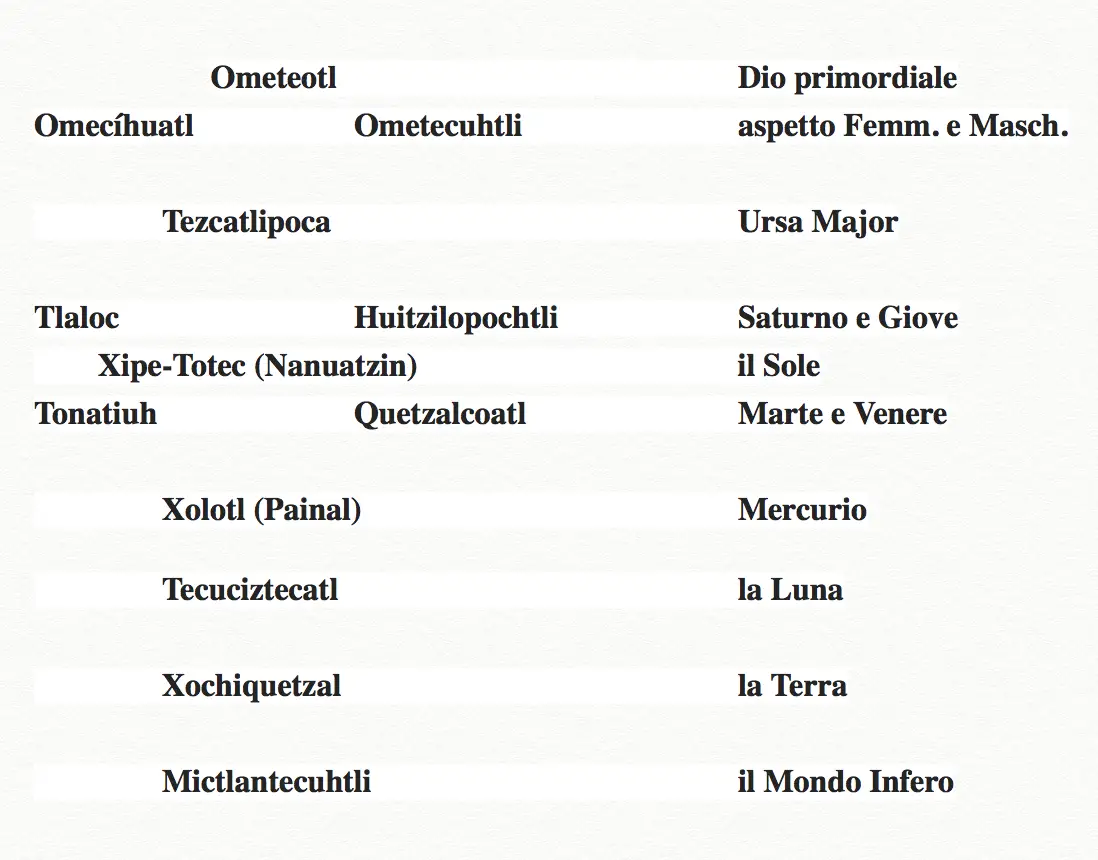
Bibliography:
- Torres, Yolotl Gonzalez, The cult of the stars among the Aztecs (Mimesis, 2004).
- Helfritz, Hans Ancient America. Aztecs, Maya, Incas (The School, 1968).
- Cotterell, Arthur The great encyclopedia of myths and legends (Rizzoli, 1990).
- Prampolini, James Mythology in the life of peoples (Hoepli, 1938).

Wonderful article, beautiful! Like everything else on the site. Congratulations! I say this as a scholar of pre-Columbian civilizations.
Heartfelt thanks Alfredo!
(Sorry for the delay in responding, but your comment had escaped me and I just read it now!)